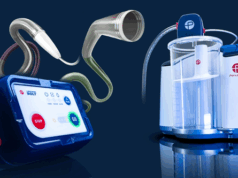
Penumbra, a global healthcare company focused on innovative therapies, announced the latest STRIKE-PE data evaluating Penumbra’s Indigo aspiration system with Lightning. The results show Penumbra’s computer assisted vacuum thrombectomy (CAVT) is safe and effective at reducing right heart strain.
It also improved clinical outcomes, including heart rate and respiratory rate, and functional outcomes, including dyspnoea, walking distance and New York Heart Association (NYHA) classification, when used to treat acute high and intermediate risk pulmonary embolism (PE). The data were presented at this week’s Vascular Interventional Advances (VIVA; 30 Oct–1 Nov, Las Vegas, USA) conference.
“The latest STRIKE-PE data looking at the first 150 patients show that not only is Penumbra’s Indigo system safe and effective for removing thrombus, but also confirm that the removal of the clot can have a significant, positive physiologic impact on patients,” said James F Benenati, chief medical officer at Penumbra. “The latest STRIKE-PE data add to the growing body of evidence that demonstrates the significant benefits of CAVT, which is redefining the way physicians treat significant symptomatic pulmonary emboli.”
Penumbra’s CAVT is designed to allow physicians to remove large blood clots in the body safely, simply and with speed. The interim results of the prospective, multicentre study, which evaluated Penumbra’s Lightning technology in 150 of 600 anticipated patients to be enrolled, include:
Safety & Performance:
- Low 48 hour major adverse event rate of 2.7%
- Low 48 hour major bleeding rate of 2.7%
- Significant reduction of right ventricle/left ventricle ratio by 25.7%
Functional Measures:
- Significantly improved patient reported shortness of breath (dyspnoea) by discharge with increasing improvement by 90-days
- Functional ability, measured by six-minute walk distance, significantly increased by 120 meters from discharge to 90-days
- Patients returned to pre-PE state with no significant difference in NYHA classification from before the event to 90-days
“The complexity of treating pulmonary embolisms appropriately cannot be overstated. They are often complicated to diagnose and, in many cases, if not treated quickly, can be life-threatening,” said Ido Weinberg (Massachusetts General Hospital, Boston, USA) who presented the data. “While surviving a pulmonary embolism is a victory, patients regaining their quality of life and ability to function without ongoing limitation is critical. The STRIKE-PE data set is very encouraging as it confirms the promise of CAVT to restore blood flow quickly, safely and effectively while also showing promising, prompt and lasting improvement in patient outcomes.”
Additional STRIKE-PE data were previously presented at the recent TCT annual scientific meeting, showing improved quality-of-life outcomes, including improved mobility and ability to provide self-care and a decrease in pain/discomfort from discharge to 90-day follow-up.
“The real-world data from STRIKE-PE allow us, for the first time, to continuously evaluate the impact of intermediate and high-risk PE treated with CAVT,” said John Moriarty (University of California Los Angeles, Los Angeles, USA) principal investigator of the STRIKE-PE study and interventional radiologist. “The latest results continue to show improved functional outcomes and quality of life, suggesting that CAVT should be considered as a valuable frontline treatment option.”
In the USA, an estimated 900,000 cases of symptomatic PE occur annually. Incomplete physical recovery after PE has been documented as a common outcome as patients often report decreased quality of life and persistent shortness of breath. Pulmonary embolism can be life-threatening with 10–30 percent of individuals dying within one month of diagnosis.
“We believe that our CAVT technology will help transform care so PE patients can return home quickly with minimal impairments and minimal impact on their quality of life,” said Adam Elsesser, president and chief executive officer of Penumbra. “The latest STRIKE-PE data confirm that the safety, speed and simplicity of our devices can have a lasting impact on patients and our focus on clinical evidence will continue to advance the patient care paradigm.”
Penumbra is also conducting STORM-PE, a first-of-its kind randomised controlled trial comparing CAVT using Penumbra’s Lightning Flash with anticoagulation versus anticoagulation alone, with the goal of showing the clinical benefits to patients who receive CAVT.










